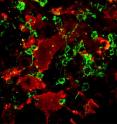The sweet mysteries of the nervous system
The antibody 5750 recognises a specific sugar residue on the cell surface, which is called LewisX. The research group lead by Prof. Dr. Andreas Faissner has now been able to use LewisX for the first time to separate different types of stem cells. The researchers report on their results in the Journal of Biological Chemistry. Unexpected sugar diversity
Antibodies that recognise the LewisX sugar residue are used routinely to identify so-called neural stem cells from which the various cells of the nervous system originate. Prof. Faissner's team has now shown that the designation "LewisX" does not just cover a single sugar motif, but a whole range of different sugar residues. Different types of neural stem cells are equipped with individual combinations of LewisX sugar residues on their cell surface. The new Bochum antibody 5750 recognises a different LewisX sugar residue to the antibodies previously used. "This sugar diversity could also be interesting for cancer diagnosis" Prof. Faissner explained, "because LewisX sugars have also been detected on tumour cells".
Identifying properties of stem cells
With the aid of the new antibody 5750, certain types of neural stem cells can be isolated from a mixture of different cell types. The aim of Prof. Faissner's research group is now to examine the properties of the stem cells which carry the LewisX sugar residues. The researchers have already found out that the LewisX motif on the cell surface changes when the stem cells develop further – for example into oligodendrocytes, which form the insulation layer of the nerve cells, or into nerve cells themselves.
Source: Ruhr-University Bochum
Other sources
- The sweet mysteries of the nervous systemfrom Science BlogTue, 10 May 2011, 15:00:14 UTC
- The sweet mysteries of the nervous systemfrom PhysorgTue, 10 May 2011, 14:30:39 UTC
- Sweet mysteries of the nervous systemfrom Science DailyTue, 10 May 2011, 14:30:19 UTC
